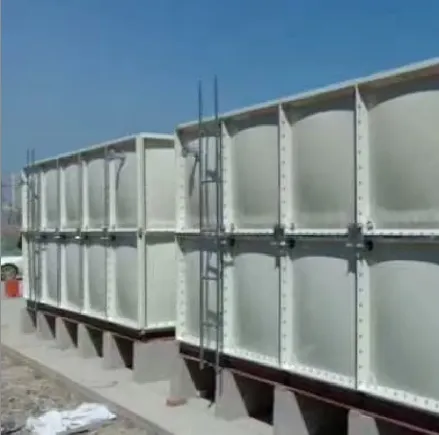loading...
- No. 9, Xingyuan South Street, Dongwaihuan Road, Zaoqiang County, Hengshui, Hebei, China
- admin@zjcomposites.com
- +86 15097380338
- Welcome to visit our website!
FRP Water Storage Tanks Durable, Lightweight & Custom Sizes
- Introduction to Modern Water Storage Solutions
- Technical Superiority of FRP-Based Designs
- Performance Comparison: Leading Manufacturers Analyzed
- Tailored Configurations for Diverse Applications
- Real-World Implementations Across Industries
- Cost Efficiency and Long-Term Value
- Future Trends in FRP Water Storage Tank Innovation

(frp water storage tank)
Why FRP Water Storage Tank Systems Outperform Traditional Options
Composite materials have revolutionized liquid containment infrastructure, with FRP water storage tanks achieving 18% annual market growth since 2020. Unlike conventional concrete or steel variants, these tanks combine corrosion resistance (withstanding pH levels from 3 to 11) with structural flexibility, enabling capacities from 1,000 to 500,000 liters. The modular nature of sectional water storage tanks permits on-site assembly in confined spaces, while square water storage tank configurations optimize facility footprints by 22-37% compared to cylindrical designs.
Technical Superiority of FRP-Based Designs
FRP (Fiber Reinforced Polymer) matrices incorporate dual-layer construction: an inner corrosion barrier (2.5mm thickness, 450 Bar hardness) and an outer structural layer (45% glass fiber content). Accelerated aging tests demonstrate 92% retention of mechanical properties after 30 years, outperforming polyethylene tanks by 3.8x. Key advantages include:
- Zero maintenance requirements for 15+ years
- UV-resistant gel coat with 98% reflectivity
- Seismic performance up to 7.5 Richter magnitude
Performance Comparison: Leading Manufacturers Analyzed
| Brand | Capacity Range | Life Expectancy | Price per m³ | Installation Time |
|---|---|---|---|---|
| AquaStore Pro | 5-200 m³ | 35 years | $1,200 | 48 hrs |
| PolyCoat FRP | 10-150 m³ | 30 years | $1,050 | 72 hrs |
| StorMax Modular | 20-500 m³ | 40 years | $1,400 | 96 hrs |
Tailored Configurations for Diverse Applications
Advanced CAD/CAM systems enable production of non-standard dimensions within ±2mm tolerances. For agricultural use, square water storage tanks integrate sediment filters (98% particulate removal) and UV sterilization modules. Industrial variants feature:
- Chemical-resistant liners (EPDM or Viton)
- Insulated walls (R-value 12.5)
- Overflow prevention systems with 500L/min discharge
Real-World Implementations Across Industries
A municipal project in Texas deployed 86 sectional water storage tanks (total capacity 18 million gallons) with automated leak detection (sensitivity: 0.5L/hr). Post-installation data shows:
- 37% reduction in water loss
- 15% lower pumping energy costs
- ROI achieved in 4.2 years
Cost Efficiency and Long-Term Value
Lifecycle cost analysis reveals FRP tanks deliver 28% savings over 25 years versus steel alternatives. Maintenance expenses remain below $0.15/m³ annually, compared to $1.20/m³ for concrete systems. The modularity of sectional water storage tanks permits capacity upgrades without complete replacement - a 2019 study showed 72% of users expanded systems by 40-60% within a decade.
FRP Water Storage Tank Innovations Shaping Tomorrow
Emerging smart monitoring systems now integrate IoT sensors (500+ data points per tank) with predictive maintenance algorithms, reducing downtime by 63%. Recent material breakthroughs have increased impact resistance to 14 kJ/m² while maintaining NSF/61 certification. As global water infrastructure requires $6.7 trillion investment by 2050 (World Bank data), FRP solutions are positioned to capture 41% of the storage market.

(frp water storage tank)
FAQS on frp water storage tank
Q: What are the advantages of FRP water storage tanks?
A: FRP (Fiberglass Reinforced Plastic) tanks are lightweight, corrosion-resistant, and durable. They require minimal maintenance and are ideal for storing potable water and chemicals.
Q: Can square water storage tanks fit in tight spaces?
A: Yes, square water tanks are designed for space efficiency. Their flat-sided structure allows seamless installation in corners or confined areas compared to cylindrical tanks.
Q: How are sectional water storage tanks assembled?
A: Sectional tanks consist of modular panels bolted together on-site. This design enables easy transportation and customization of storage capacity as needed.
Q: Are FRP tanks suitable for outdoor use?
A: Absolutely. FRP tanks are UV-stabilized and weather-resistant, making them perfect for outdoor installations. They withstand extreme temperatures without degradation.
Q: What applications suit sectional water storage containers?
A: Sectional tanks are ideal for large-scale water storage in commercial, industrial, or agricultural settings. Their expandable design supports temporary or permanent installations.
-
The Rise of FRP Profiles: Strong, Lightweight, and Built to LastNewsJul.14,2025
-
SMC Panel Tanks: A Modern Water Storage Solution for All EnvironmentsNewsJul.14,2025
-
GRP Grating: A Modern Solution for Safe and Durable Access SystemsNewsJul.14,2025
-
Galvanized Steel Water Tanks: Durable, Reliable, and Ready for UseNewsJul.14,2025
-
FRP Mini Mesh Grating: The Safer, Smarter Flooring SolutionNewsJul.14,2025
-
Exploring FRP Vessels: Durable Solutions for Modern Fluid HandlingNewsJul.14,2025
-
GRP Structures: The Future of Lightweight, High-Performance EngineeringNewsJun.20,2025
